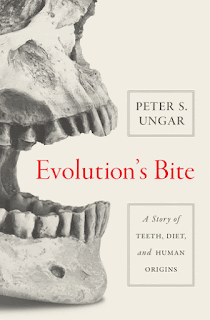 He applied the “Page 99 Test” to his new book, Evolution's Bite: A Story of Teeth, Diet, and Human Origins, and reported the following:
He applied the “Page 99 Test” to his new book, Evolution's Bite: A Story of Teeth, Diet, and Human Origins, and reported the following:From page 99:Learn more about Evolution's Bite at the Princeton University Press website.
Cerling was an undergraduate majoring in geology and chemistry at Iowa State University in the late 1960s and early 1970s. The geology department there at the time was on the rise, with a fresh infusion of creative and energetic young scholars like Carl Vondra, who studied the accumulation of sediments at fossil hominin sites. And the chemistry department was keen on students double majoring. Harry Svec, an alumnus of the Manhattan Project, was at the time pioneering new approaches to combining chemistry and geology. Cerling took full advantage of the opportunities that Iowa State had to offer and managed to score an invitation to help map sediments on the eastern shore of Kenya’s Lake Rudolf (now Lake Turkana). The hominin fossil rush in eastern Africa was starting to heat up, and there was much to do to understand the geology of the new sites. What he learned in those early years about geochemistry and tracing deposits across the landscape would serve him well into the future.Page 99 of Evolution’s Bite presents the story of Thure Cerling, an important figure in paleoclimate research. He is a founding father of the use of chemical signatures in soils to reconstruct past environments. And his work provided pivotal evidence used to trace the spread of savannas across eastern Africa millions of years ago. This helps us understand the conditions under which our hominin ancestors evolved, those that triggered human origins.
Cerling continued to work in Kenya through the 1970s during his graduate school years at Berkeley. His passion was the chemistry of sediments, and he began to collect the popcorn-like calcium carbonate nodules that accumulated over time at the sites. He spent months each year walking the deposits, gathering samples from each of the layers that had produced fossil hominins. It was blistering work, tracing layers of rock and sediment mile after mile, day after day, across the hot and dusty badlands on the eastern edge of the lake. The search took him up, down, and around erosional gullies and barren hills broken only by the occasional bush or acacia tree. I’ve always been jealous of geologists who can look out over a desolate landscape and see the past. Rocks and dirt become ancient streambeds, river deltas, and lake shorelines in their mind’s eye. Cerling knew exactly where to sample.
Is page 99 representative of Evolution’s Bite as a whole? Yes and no. The book starts with the premise that we hold in our mouths the legacy of our evolution. The basic idea is that we can use teeth, living and fossil, along with an understanding of climate variation over deep time and how animals earn a living from their surroundings, to understand how a changing world made us human. It begins with the earliest mammals, during the age of the dinosaurs, and takes the reader from milestone to milestone -- our early, apish ancestors, the first humans, the origins of agriculture.
The text on page 99 has nothing to do with teeth and it has nothing to do with human evolution per se. But it does provide a piece to the puzzle. Evolution’s Bite builds the case, bit by bit, bringing together evidence from paleontology, primatology, climate research, archaeology, and myriad other disciplines. And it brings the tale to life through the stories of the scientists, and by peering over their shoulders as they made the discoveries that gave us the knowledge we have today.
--Marshal Zeringue



